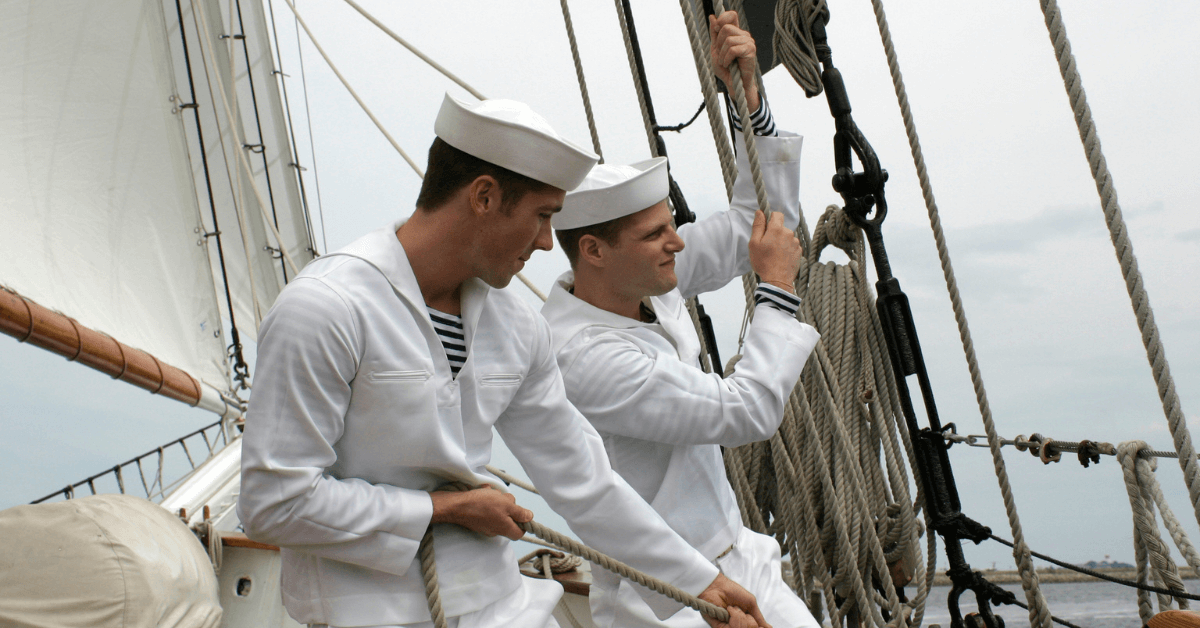What are Sea Shanties?
Long before the arrival of Radio, Television, and other technological marvels as a medium of entertainment, those folk songs and other traditional art forms kept us delighted.
Traditional art forms developed according to local cultures. These songs and stories were mainly practised within specific communities with something ordinary, such as ethnicity, region, religion, or occupation.
In particular, many such folk songs were created as entertainment during work hours.
These songs, commonly known as work songs, were used to coordinate people working together and improve efficiency.
What Is a Sea Shanty?
Sailors who lived before the era of digital entertainment also developed work songs, which helped them to work smoothly aboard vessels throughout the months-long journeys.
Sea Shanties are similar work songs created and sung by sailors on the square-rigged ships of the Age of Sail, a period (16th to the mid-19th century) in which sailing ships dominated international trade and warfare.
Using a sea shanty is believed to have started to combat the monotonous nature of the demanding marine requirements.
The original purpose of the sea shanty was to give mundane chores a semblance of pleasure and merriment. Contrary to people’s interpretation, these songs were sung when the seafarers worked instead of being a tool for wasting time.
Here is an example of a Sea Shanty that appeared in the movie Moby Dick:
Shantyman: Our boots and clothes are all in pawn
Sailors: Go (pull) down ye blood red roses, go(pull) down.
‘Soon May The Wellerman Come’- A Shanty that went Viral on social media.
One of the most famous sea shanties was revived by a Scottish youth. In 2020, 26-year-old Nathan Evans, an aspiring singer from Scotland, sang a sea shanty and uploaded his video on TikTok. Soon, the shanty called ‘Soon May the Wellerman Come’ swept the internet, with musicians, maritime enthusiasts, content creators, and dancers creating their reels and posts using the audio. It became a popular trend for many months.
Interestingly, the subject of this shanty was based on a true Story. The lyrics talk about the Weller brothers whaling company and its outpost in Otago, New Zealand. They mention whalers harpooning a whale and hoisting it on the vessel for butchery. Sailors must have sung it while butchering a whale since whale oil was important for making various products like cosmetics, lotions, etc.
Interestingly, these shanties tell much more. They mirror a region’s maritime past. This shanty also tells us that the crew of whaling vessels was diverse. Edward Weller married a Maori woman who was a local to the New Zealand whaling community.
Apart from this, many shanties highlight different kinds of onboard work sailors undertook in those times.
According to Gerry Smyth, Professor of Irish cultural history at Liverpool John Moores University, the sea shanties created a sense of community and purpose among sailors on merchant marine vessels in the 1700s and 1800s. The professor has also authored the Sailor song: The Shanties and Ballads of the High Seas. He argues that they were created to match the tasks the sailors regularly did. For example, if the vessel were being hauled, the shanty would be about the physical effort being put in. Everyone would pull to the rhythm of the song’s harmony.
Origin of Sea Shanty
The origin of the word shanty remains unknown despite several inconclusive theories. According to the consistently offered claim, the etymological origin of the shanty is from the French word Chanter, which means “to sing.”
The word shanty was believed to have been introduced in the mid-19th century to denote a distinct genre of work song, which was developed especially in American-style merchant vessels.
However, while the evolution of chanter to shanty is accepted widely worldwide, in the then-modern American marine lingo, the term chanter was transformed to “chantey” to separate contextual connections with the British jargon.
Types and Usage of Sea Shanties
Among other work songs, the shanty genre remains distinct due to its formal characteristics and specific manner of use.
Typically, a shanty was performed in a call-and-response format, in which one sailor would call out a verse, prompting other sailors to respond in unison.
A shantyman would start the lyrics within these two parts, known as the chant and the chorus, establishing the beat only to let the chorus join in.
The songs were divided into several categories according to the group of labourers they belonged to. The shanties are generally divided into three categories: the long haul, short haul and Capstan shanties.
Long-haul shanties, also known as halyard shanties, were sung during heavy jobs that were carried out for a long time. They are mostly used to coordinate hauling and are often used to set sails. A chorus comes at the end of each line for this type of shanty.
Deep breathing helps the sailors coordinate and get a fresh grip between pulls. ‘Blow the Man Down is one of the popular long-haul shanties.
The short-haul or short-drag shanties were used for tasks requiring quick pulls over a relatively short time. Sung during the unfurling or shortening of sail, these songs feature a steady rhythm, helping the sailors work simultaneously to get the job done safely and efficiently.
‘Paddy Doyle’s Boots’ is one of the short-haul shanties sung while furling the sails. Sailors used the Capstan or the Windlass shanties for long, repetitive tasks that required a sustained rhythm.
The song was used when the crew around the Capstan raised and lowered heavy sails or the ship’s anchors. ‘Drunken Sailor’ is perhaps one of the most famous capstan shanties known to the public.
In addition to these, there were songs known as Pumping shanties, which were practised when battling leaks in wooden ships.
As the old wooden sailing ships slightly leaked naturally, it was gruelling work for the seamen to drain the water in the bilge. Similarly, the whaling shanties denote the difficulties of working aboard a whaling ship.
Sailors abroad on whaling ships face the worst and most life-threatening circumstances, undertaking months-long journeys. These whaling shanties gave them the strength to overcome and survive the harshness and dangers.
As mentioned earlier, the sea shanties’ rhythms helped sailors coordinate the vessel’s efforts abroad. Thus, these working songs focused on the rhythm and beat, allowing every sailor to sing and be part of the group.
Similarly, seafarers weren’t expected to possess excellent singing skills, as the sole purpose of these songs was to maintain a unique line of command that would help them carry out their work more orderly.
Likewise, every song’s melody and lyrics used to be impromptu, conjuring instead of a planned and detailed composition.
The ditty’s lyrics and the tune are used to follow the chore’s pattern and movement. As we discussed, from the direction of the horizontal windlasses to the raising of the winches and sails, each chore had a sea shanty composed and belted out by the sailors.
With the huge role that the sea shanties have to play abroad, the sailing vessel, the integration of sea shanties in the day-to-day lives of the sailors was an essential feature of the marine days of the 19th century.
Apart from tagging and composing verses while carrying out sailor duties, seafarers also used sea songs to reconnect with their kith and kin left behind on land.
Such sailor songs were different from sea shanties and were called fo’c’sle, the tag derived from the housing accommodations of the seafarers on the vessel.
These songs were poignant and highly emotional and helped the sailors to develop an additional sense of belonging in the vast ocean.
The Decline of Sea Shanties’ Culture
Like work songs, shanties flourished for about five decades since their birth, minimising the burden of work aboard ships.
However, the development of vessel construction and technology aboard ships paved the way for more streamlined vessels.
The resultant reduction in time and effort required by seafarers to carry out even the simplest routine tasks led to the decline of sea shanties in the 1900s.
Still loved by modern sailors, the sea shanties are now rarely used as work songs since contemporary vessels do not require a large group of people to complete a task aboard.
Though sea shanties are not actively used, sea shanty enthusiasts collect and present a vast repertoire of such sailor songs to the world.
Through the videos, and even though the available lyrics are not listed, one can try to connect with these song marvels, whose actual glimpse the maritime community will never be able to hear or visualise.
You might also like to read:
- Different Types of Sea Waves – A Comprehensive List
- 10 Interesting Facts About The Straits Of Gibraltar
- 7 Interesting Facts About The Scapa Flow
- 5 Strait of Magellan Facts You Must Know
- 10 Important Panama Canals Facts Everyone Should Know
Disclaimer: The author’s views expressed in this article do not necessarily reflect the views of Marine Insight. Data and charts, if used, in the article have been sourced from available information and have not been authenticated by any statutory authority. The author and Marine Insight do not claim it to be accurate nor accept any responsibility for the same. The views constitute only the opinions and do not constitute any guidelines or recommendation on any course of action to be followed by the reader.
The article or images cannot be reproduced, copied, shared or used in any form without the permission of the author and Marine Insight.
Do you have info to share with us ? Suggest a correction
Related Posts
Subscribe To Our Newsletters
By subscribing, you agree to our Privacy Policy and may receive occasional deal communications; you can unsubscribe anytime.
Web Stories
























Very nice article! Very informative and provided exactly the information I was looking for.
Hey, it’s “sea CHantey/CHanty” (chanter chanson, cantar, cancion, Gregorian chant), get it? NOT “SHanty”. A “shanty” is a shack, a small,mean dwelling, a hut.
My favorite is “Haul Away Joe” — “When I was a little boy, this my mother told me (“Sing now!”) “Way haul away! We’ll haul away Joe!”
“That if I did not kiss the girls, me lips would grow all mouldy!” (“Sing now!”) “Way haul away! We’ll haul away Joe!”.
“King Louie was the king of France before the revolution” (“Way haul away…!”) “But then he got his head cut off, which spoilt his constitution!” (“Way haul away…!”)
Another song that I suspect was originally a sea chantey is the (now) Christmas carol “I Saw Three Ships”.
And for those determined to be hip, check out Bruce Springsteen’s Irish album with its “I Thought I Heard My Captain Say”, in which he has the entire audience CHanting.
Thanks for a great article. Way back in the 70s, we young officers amused ourselves by singing bawdy sea songs like “4 and 20 Virgins” and “Waltz me around.”
We were in a remote location with few amusements.